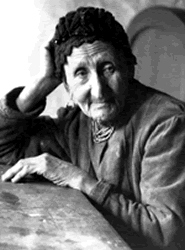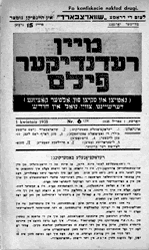Alter Kacyzne
www.yiddishbookcenter.org/+10249
31 May 1885 — 7 July 1941

Alter Kacyzne (pronounced ka•tsíz•neh) was born in Vilna, then part of the Russian Empire, on May 31, 1885. His family was distinctly working class: his father was a bricklayer and his mother a seamstress. His parents' poverty made it impossible for their son to receive the mixture of traditional and secular education that so many Yiddish writers drew upon in their writing. So Kacyzne studied by himself, mainly by reading voraciously. As a young man, he was already fluent in Russian, Polish, German, French, and Hebrew in addition to his native Yiddish. After his father's death, when Kacyzne was 14, his favorite uncle took him on as an apprentice photographer. This was to be the main source of Kacyzne's livelihood for his entire life. As a photographer, Kacyzne traveled around Poland, Palestine, and North Africa, capturing incredible images of Jewish life. These photos were published throughout Europe and in America in the Yiddish daily Forward. Many of these photos, such as this one, were reprinted in the recently published collection, Poyln.
In 1909, Kacyzne found himself in a fully Russian environment in Yekaterinoslav (today, Dnipropetrovsk), where he made his literary début in Russian in a literary journal edited by S. An-ski (who later became famous as the author of The Dybbuk). After reading Y. L. Peretz, Kacyzne decided that his literary future was most certainly to be in Yiddish, and he packed up his things and in 1910 moved to Peretz's city, Warsaw. He was immediately embraced by Peretz who, as Kacyzne would later write, "taught me how to write in Yiddish, very systematically. The system? I would write something, and Peretz would cross it out." Kacyzne's first Yiddish work was an appreciation of his mentor after Peretz's death in 1915.
Kacyzne became widely recognized by the Warsaw literary scene as the "successor" to Peretz. He consistently published new and engaging work: essays, short stories, plays, as well as translations of world literature into Yiddish. He also authored a sweeping, two-volume novel, Shtarke un shvakhe — The Strong and the Weak, a colorful, elaborate collage of characters and places in Poland from the earliest part of the twentieth century to the late 1920s. Kacyzne's summer villa in ?wider, outside of Warsaw, was the place to be for the most vibrant Yiddish writers of the day.
Kacyzne was an editor of numerous literary journals and eventually the editor, writer, and publisher of his own bimonthly magazine, My Talking Film, in which he printed essays on current events, art, and culture, as well as his own plays, screenplays, and translations of world literature. An issue from April 1938 is on the left. Throughout the early twentieth century, Kacyzne's work was greeted with extreme reactions: the critics either loved Kacyzne or couldn't stand him. He received especially great acclaim for his long-form dramatic poems. Writing about Kacyzne's first published poem Der Gayst der melekh — The Spirit, the King, the critic Baal Makhshoves extolled, "Not only are the motifs exceptionally original but also masterfully executed — achieving such beauty that it establishes him immediately as a poet in his own right." The most negative responses were generally reserved for his sprawling historical dramas such as Prometheus, The Duke, and Herod. But his sharpest critics agreed that, even in these works, Kacyzne consistently "enriched the modern Yiddish theatrical repertoire."
It was in the pages of My Talking Film that Kacyzne printed Shvartsbard, the last of his plays ever to be performed. The play centered on the sensational trial of Sholem Shvartsbard, who murdered the Ukrainian leader Petliura in revenge for the Ukrainian pogroms of 1919. Shvartsbard premiered in ?ód? starring the incomparable actor Alexander Granach (Nosferatu, Hangmen Also Die), but was shut down by the Polish censor after only a few performances. Afterwards, the play was produced, with various different titles, in Kovno, Riga, São Paulo, and Johannesburg. In 1940, the play was staged by in Los Angeles, inspiring Academy-Award-winning actor Joseph Schildkraut (The Life of Emile Zola, The Diary of Anne Frank) to commission an English translation. It was adapted as a French radio play, broadcast in the 1979. The play fused theatrics with real life in its condemnation of nationalist violence.
Ten years after Shvartsbard was shut down, Kacyzne found himself fleeing Lwów (today, L'viv) as the German army swept across Poland into Ukraine. He made it as far as the Galician town of Tarnopol, just one day after the Germans had entered. On July 7, 1941, Alter Kacyzne was murdered in an unimaginably savage pogrom led by killing squads made up of Ukrainian nationalists. Perhaps Kacyzne's most memorable work will be his haunting masterpiece preserved on film — his screenplay of An-ski's The Dybbuk.
